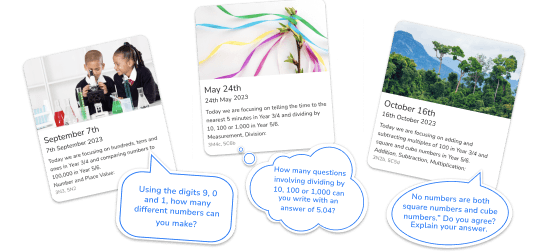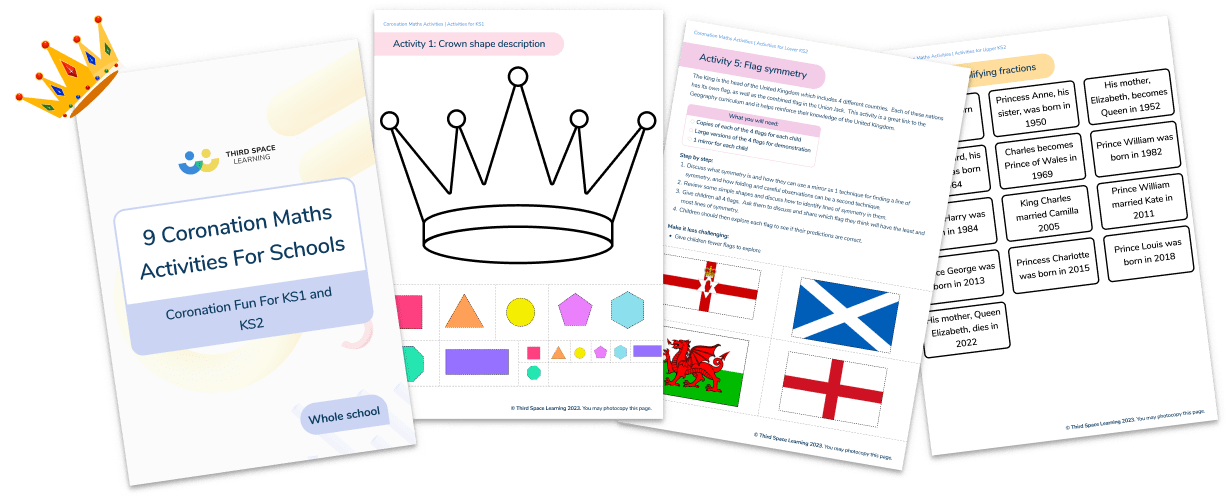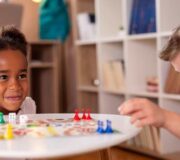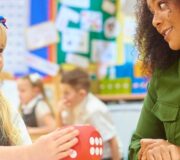9 Coronation Maths Activities For Schools: Coronation Fun For KS1 and KS2
The King’s Coronation provides a great opportunity to engage children in open-ended problem solving and creative maths activities. Celebrate this historical event while linking in with key areas of the maths curriculum with our Coronation activities.
In this blog, we provide you with 9 Coronation maths activities to try out with your KS1 and KS2 classes to celebrate the Coronation of The King and Queen Consort. We also include ideas to adapt each activity to suit your pupils’ needs.
When is the Coronation?
The Coronation of The King and Queen Consort will take place on Saturday 6th May 2023 at Westminster Abbey. An additional bank holiday has been announced for Monday 8th May 2023 and the long weekend will host several other events in addition to the Coronation service, including The Big Lunch and The Big Help Out.
This long weekend has altered dates for SATs 2023, with each test taking place one day later than originally planned.
However, with the end of the year in sight, it’s a great time to revisit skills learnt earlier in the year. Problem solving activities can ensure that new skills are embedded and that children can apply their knowledge within new contexts, all while celebrating a historic event.
Coronation maths activities
This is a busy time of year, so the resources and preparation for these activities has been kept low and we’ve included a downloadable, printable pack with everything you’ll need.
They are all stand-alone activities so you can pick and choose those that would best suit the revision or teaching needs of your class. Alternatively, choose the areas of learning that you know your pupils will love engaging with to celebrate the Coronation!
We’ve organised the activities into KS1 and KS2 and suggested the year groups for which they are best suited. However, all can be adapted to suit the needs of your class and we’ve suggested how you can reduce and increase the challenge.
We’ve even included an outdoors activity so if the weather is warm you can make the most of the sunshine with your pupils!
KS1 activities
Crown shape description
This is a fun and interactive activity for pupils that gives a rich discussion opportunity to encourage children to name and describe 2D shapes accurately and to describe the position of shapes to enable a partner to build matching crowns.
What you will need
- Multiple copies of different shapes
- Crown templates
- Scissors
- Glue
- A4 plain paper
9 Coronation Maths Activities For Schools
Coronation fun for KS1 & KS2! This pack contains 9 activities that can recap past topics and even introduce new topics in an engaging way!
Download Free Now!Step by step
- Show the 2D shapes and review the names and their properties.
- Practise using and describing shapes. This will model the description of shapes and review the mathematical language they will need later in the lesson.
For example: “I’m thinking of a shape that has 3 sides, what is it?” - Show 3 shapes and position them purposefully on the crown template. Ask the pupils how they would describe the positions of the shapes so that someone else could recreate the design on their own crown template.
- Discuss as a whole class and make a phrase bank of important phrases pupils may need later in the lesson. This may include:
- above
- below
- next to
- on the left
- on the right
- Give pupils a crown template and a set of shapes. Explain to pupils that you would like them to use 10 of the shapes to create their own, individual crown design and stick them onto the crown template.
- Once pupils have designed their crowns, give a set of cut out shapes and a new crown template. Ask pupils to sit back to back and describe their crown design to their partner. Refer to the phrase bank to support pupils’ descriptions. The pupils must then recreate their partner’s crown design. Pupils then swap roles.
Make it less challenging
Give fewer, more simple shapes for pupils to create their design
Make it more challenging
Include shapes of varying sizes sizes so that pupils must include this additional information in their descriptions
Outdoor maths
Hopefully, the sun will be shining this May and you will be able to get outdoors for a memorable activity to celebrate the Coronation. Taking maths outside is a great way to allow pupils to see and think about numbers in a new way and allow them to be really creative. This activity involves finding objects in the school field or playground to represent the date of the King’s Coronation.
What you will need
An outdoor space
Step by step
- Explain that Charles is to be coronated on 06.05.23.
- Discuss this date. How is the date represented – day in the month, month of the year, and the year. Discuss how pupils work out which is the 5th month. Discuss how to read the whole date in words.
- Explain that you are going to set them a challenge. Pupils must find objects outside that represent the date, e.g. they could find 6 leaves, 5 flowers and 23 stones. Pupils can work in small groups or pairs – this will encourage purposeful maths talk.
- Pupils then need to arrange these to show the date and photograph it. They need to count carefully to make sure that they have exactly the right number of each object.
Make it less challenging
Pupils could find objects to represent the day and the month only.
Make it more challenging
Explain that Charles became king the day his mother died, and can they extend the activity to find objects to represent a second date: 10.09.22.
Lower KS2 activities
Coronation timeline
Westminster Abbey has been Britain’s Coronation church since 1066. King Charles III will be the 40th reigning monarch to be crowned in May 2023.
In this activity, pupils will order the dates of the Coronations that have taken place since 1066 and then mark their positions on a timeline. This will give pupils great practice at comparing and ordering 4 digit numbers, in addition to reading years correctly.
What you will need
- Timeline cards
- Timeline
Step by step
- Begin the activity by sharing information about Westminster Abbey and its significance and history. Explain that it has been the building where Kings and Queens have been crowned and this tradition stretches back to 1066. Explain that Charles will be the 40th person to be crowned there.
- Display the 4 most recent Coronations on the board: George VI 1937; Elizabeth 1953; George V 1911; Edward VII 1902.
- Ensure that pupils understand how to read these as years e.g. nineteen twenty, rather than one thousand nine hundred and twenty. Explain that we do this for years as 2 digit numbers are easier to understand and read, so we read the digits in pairs of 2 digit numbers. Practise reading the names on the board as a class.
- Using the 4 years on the board, discuss with pupils how to order the dates from the earliest to the most recent coronation. Discuss looking at the most significant digit in the thousands column and comparing, then the hundreds column, then the tens column and finally, if necessary, the ones column. Discuss and agree the correct order for the 4 cards.
- Display a blank timeline going from 1000 to 2100, marked in 100s. Discuss how to approximate the position of the 4 dates and mark them on.
- Explain that you are going to give them the names and years of the 40 kings and queens crowned at Westminster Abbey. In pairs, pupils are to order the dates and mark them onto a timeline.
Make it less challenging
Give fewer dates to order
Give a timeline marked in 10s
Make it more challenging
Give a blank timeline and pupils should make their own additional divisions.
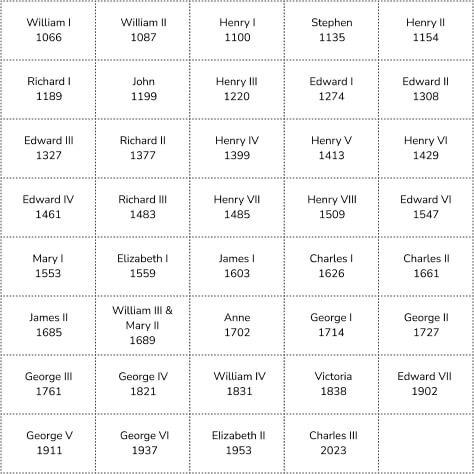
What’s the most popular monarch’s name?
After completing the previous activity, which explores the kings and queens crowned at Westminster Abbey, pupils may comment on the repetition of names. This makes this next activity a great natural follow up that can be cleverly posed as their idea.
In this activity, pupils draw a graph to show the most popular names of British monarchs in history.
What you will need
- Monarch name cards (or you can reuse the timeline cards from the previous activity, if you are planning on completing both)
- 1cm squared paper
Step by step
1. If you didn’t complete the previous activity before this one, share some information about Westminster Abbey and its significance and history. Explain that it has been the building where Kings and Queens have been crowned and this tradition stretches back to 1066. Explain that Charles will be the 40th person to be crowned there.
2. Explain that Charles is in fact the 3rd King to be ‘King Charles’ and to differentiate him from the other kings of the same name.
3. As Roman numerals are used, ensure that pupils understand how to read and use Roman numerals.

4. Consider practising this skill with mini whiteboards so that pupils must both read and produce roman numerals.
5. Once pupils are confident, show the name cards and ask pupils to write the number that corresponds to the roman numeral, and practise reading it as Charles the third, etc.
6. Ask pupils: “Which name do you think is the most common name for a monarch? How can we find this out?”
7. Then ask pupils to group the names, so that the cards are organised in stacks on top of each other. If possible in your classroom, you could even draw an x-axis on the desk using a dry-wipe marker and position the cards to create a physical graph on the desk.
8. Provide pupils with 1cm squared graph paper. Support pupils in labelling the x and y axis. Pupils must then draw a graph to show the results.
Making it less challenging
Instead of drawing their own graph, pupils can make the graph using the cards and can label the axis using dry-wipe markers. Pupils can record their graph by taking a photograph
Making it more challenging
Ask pupils to write sentences to explain what the graph shows, using sentence stems you provide:
- The graph shows the most common name is….
- The graph shows the least common names are…
- The graph shows that the names … and … have an equal number of monarchs with these names.
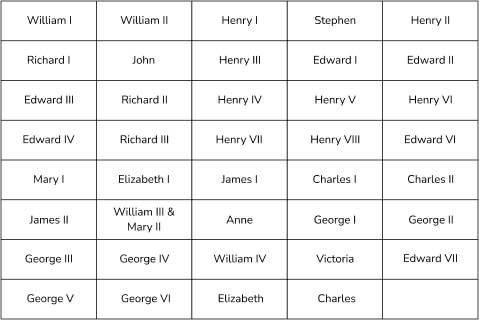
Flag symmetry
The King is the head of the United Kingdom which includes 4 different countries. Each of these nations has its own flag, as well as the combined flag in the Union Jack. This activity is a great link to the Geography curriculum and it helps reinforce their knowledge of the United Kingdom.
What you will need
- Copies of each of the 4 flags for each child
- Large versions of the 4 flags for demonstration
- 1 mirror for each child
Step by step
- Discuss what symmetry is and how they can use a mirror as 1 technique for finding a line of symmetry, and how folding and careful observations can be a second technique.
- Review some simple shapes and discuss how to identify a line of symmetry in them.
- Give children all 4 flags. Ask them to discuss and share which flag they think will have the least and most lines of symmetry.
- Children should then explore each flag to see if their predictions are correct.
Making it less challenging
- Give children fewer flags to explore
Coronation coordinates
Coordinates are great fun and this variation on a battleships style game should be exciting and a great way to discuss and use coordinates in an engaging way with your Year 4 pupils. Pupils will decorate their own coordinate grid using items connected to the King’s Coronation. Then, they must try to guess the position of their partner’s items by calling out coordinates to locate them.
What you will need
- Coordinates grid – 2 per pupil
- Coordinate pieces (throne, crown, sceptre)
- Glue
Step by step
- Show the coordinates grid and mark on positions with a cross. Ask pupils to identify the coordinates.
- Then, call out coordinates and ask pupils to come and mark them on the grid. Discuss as a class whether you agree or disagree with the position and why.
- Introduce the idea of a battleships-style Coronation game by playing as a class. Show the items and explain that you have put them on the grid. Ensure you place them along the lines of the grid, not in the squares as you would in a traditional game of Battleships.
- Ask the class to guess the position of each item by calling out coordinates. If they guess an empty position, you will mark it with a cross. If they guess a position occupied by an object, you will say ‘Coronation’.
- When pupils think that they have identified the position of an object, they will say what item it is and where it is to win that object. If they guess incorrectly, they lose the object. Complete the game as a class to model how to play the game.
- Give pupils the objects and ask them to glue them into position onto a coordinate grid.
- Pair or group pupils and hand out blank grids so they can play the game together.
Make it less challenging
Give a grid with letters on the y axis and numbers on the x axis to help differentiate the parts of the coordinate
Make it more challenging
Give a larger coordinates grid and more objects
Upper KS2 Activities
Simplifying fractions
Supporting children to recognise that fractions are everywhere is really important. Also, helping them to recognise that many things can be a whole – for example, the whole of the King’s life! For example, what fraction of the King’s life has his grandchildren been alive for?
What you will need
Key information cards
Step by step
- Hand out the key information cards and discuss the Royal Family and the events that have taken place over the King’s life. Ask children to order the events from oldest to most recent.
- How long has the King’s whole life been? He was born in 1948. Ask pupils to calculate how old he is now.
- Discuss that the key events of his life represent parts of that whole e.g. Prince George was born in 1913. What fraction of his life has Prince George been alive for? 10/74. Can this be simplified? Yes, 5/37.
- What fraction of his life has Prince Edward been alive for? Discuss that it is 58/96. Can this be simplified? Yes, 29/47.
- Explain that simple fractions are considered to have the smallest numerator and denominator. Pose the problem: Which key event in his life produces the simplest fraction?
Making it less challenging
Provide children with the differences in time to remove the need to calculate this.
Provide children with a multiplication square.
Making it more challenging
What if the whole is the time since he was crowned Prince of Wales in 1952? Do you get a different simplest fraction?
Card facts
- Charles was born in 1948
- Princess Anne, his sister, was born in 1950
- His mother, Elizabeth, becomes Queen in 1952
- Prince Edward, his brother was born in 1964
- Charles becomes Prince of Wales in 1969
- Prince William was born in 1982
- Prince Harry was born in 1984
- King Charles married Camilla 2005
- Prince William married Kate in 2011
- Prince George was born in 2013
- Princess Charlotte was born in 2015
- Prince Louis was born in 2018
- His mother, Queen Elizabeth dies in 2022
Coronation baking
Up and down the country, bakers will be busy preparing tasty treats for Coronation parties over the long weekend.
Why not give your class the challenge of adjusting a recipe so that the quantities are correct to make a sweet treat to enjoy as part of your school celebrations. If they can tell you the right quantities, you’ll go shopping for them… and then you can bake a cake as a class!
Note: If you really do this, you will need to think about how many 9-inch cake tins you’ll need to split the mixture (to ensure that it cooks according to the original timing) E.g. if you have 30 children, you’d be better to make enough for 36 and make 3 cakes… because the adults want some too!
What you will need
- Copies of the recipe
- Quantities template worksheet
Step by step
- Share the recipe card and discuss the quantities for the ingredients to make a Victoria Sandwich Cake. Explain that this is a recipe for 12 slices of cake.
- How much of each ingredient will there be in 1 slice? Discuss how to divide each quantity by 12 to find out how much there will be in each slice of cake. Discuss how to use fractions to reduce the teaspoon quantities e.g. 1/12 tsp for the vanilla extract.
- How much of each ingredient will there be in 24 slices of cake?
- How much of each ingredient will be needed to make a cake big enough for everyone in the class to have a slice of?
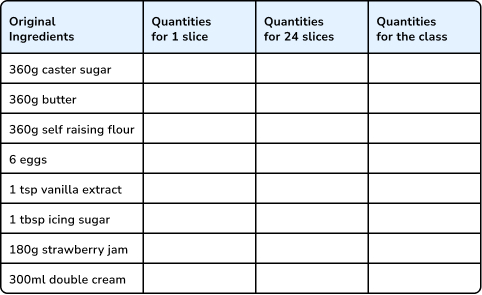
Ingredients
For the sponge cake:
360g caster sugar
360g butter
360g self-raising flour
6 eggs
1 tsp vanilla extract
1 tbsp icing sugar
For the filling:
180g strawberry jam
300ml double cream
Instructions
- Preheat the oven to 180 (160 fan, gas mark 4).
- Cream the sugar and butter together until smooth.
- Next, add the eggs one at a time with a tablespoon of the flour, mixing in between each egg to prevent it from curdling.
- Then add the vanilla.
- Slowly mix in the remaining flour until fully combined.
- Divide the mixture between two greased/lined 9-inch cake tins.
- Bake for 30-35 mins or until a knife comes out clean.
- While the cakes cool, whip the double cream until it can hold peaks.
- When completely cool, spread the jam on the underside of one cake and cream on the underside of the other.
- Carefully place the jam covered cake onto the cream covered one.
- Dust the icing sugar over the top and serve!
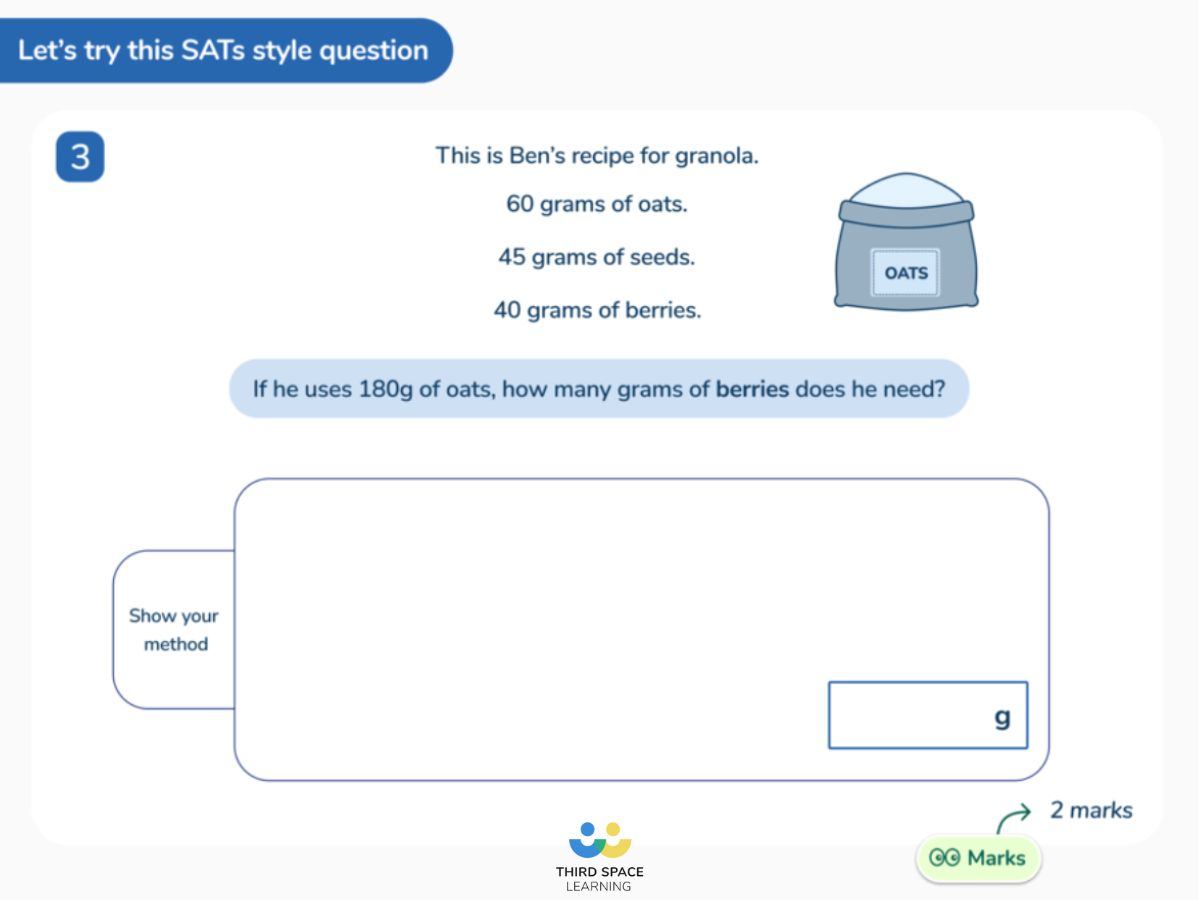
context, such as in this question from Third Space Learning’s
online one-to-one tuition SATs programme.
A date to remember!
Prince Charles will become King Charles on 06.05.2023. This activity can address lots of different areas of mental calculation. It is a naturally open-ended challenge which means that it is easily adjustable to suit learners with a range of differing abilities. For Year 6 pupils, you can include BODMAS.
What you will need
0, 6, 0, 5, 2, 0, 2, 3 digit cards
Four operation cards
Optional bracket cards
Optional indices cards
Step by step
- Display the number the date 06.05.2023. Discuss why this date is important and relate it to the King’s Coronation. In this activity, pupils must use the cards provided to make the largest possible answer using all the digit cards, and any of the operation/indices/brackets cards the pupil wants to use.
- Give children the digit cards and explain that they need to use the digit and operation cards to create a number sentence and work out the total.
- Pupils can only use each card once. If your class is familiar with the rules of BODMAS, they could have the optional brackets and indices cards to enable them to build more complex number sentences.
- Give children time to trial ideas for about 10 minutes. After that, stop the children and ask them to share the calculations they’ve been creating so far. This should help to make sure that anyone who is struggling to get going can see what they could try.
- Children then just need time to get stuck in and spend lots of time trying their ideas and trying to find the largest possible solution.
Making it less challenging
Children can use more than 1 of each card.
Making it more challenging
Can children find the smallest possible solution?
Can children find a solution which is a negative number?
Celebrating the King’s Coronation
We hope that these teaching resources can play a part in your primary school’s official celebration of the King’s Coronation. Enjoy the bank holiday weekend!
DO YOU HAVE PUPILS WHO NEED MORE SUPPORT IN MATHS?
Every week Third Space Learning’s maths specialist tutors support thousands of students across hundreds of schools with weekly primary school tuition designed to plug gaps and boost progress.
Since 2013 these personalised one to one lessons have helped over 150,000 primary and secondary students become more confident, able mathematicians.
Learn about the emphasis on building a positive maths mindset or request a personalised quote for your school to speak to us about your school’s needs and how we can help.
